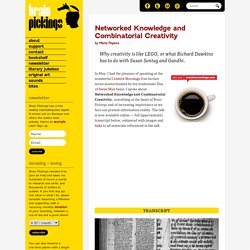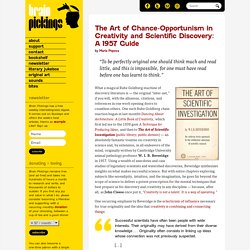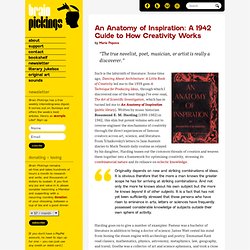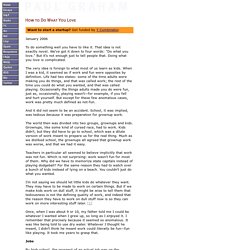

Why Creativity Necessitates Eclecticism: Nick Cave's Influences. Networked Knowledge and Combinatorial Creativity. By Maria Popova Why creativity is like LEGO, or what Richard Dawkins has to do with Susan Sontag and Gandhi.

In May, I had the pleasure of speaking at the wonderful Creative Mornings free lecture series masterminded by my studiomate Tina of Swiss Miss fame. I spoke about Networked Knowledge and Combinatorial Creativity, something at the heart of Brain Pickings and of increasing importance as we face our present information reality. The talk is now available online — full (approximate) transcript below, enhanced with images and links to all materials referenced in the talk. These are pages from the most famous florilegium, completed by Thomas of Ireland in the 14th century. In talking about these medieval manuscripts, Adam Gopnik writes in The New Yorker: Our minds were altered less by books than by index slips.” You may have heard this anecdote. Here’s the same sentiment from iconic designer Paula Scher on the creation of the famous Citi logo: Kind of LEGOs.
And I like this last part. The Art of Chance-Opportunism in Creativity and Scientific Discovery: A 1957 Guide. By Maria Popova “To be perfectly original one should think much and read little, and this is impossible, for one must have read before one has learnt to think.”

What a magical Rube Goldberg machine of discovery literature is — the original “inter-net,” if you will, with the allusions, citations, and references in one work opening doors to countless others. One such Rube Goldberg chain reaction began in last month’s Dancing About Architecture: A Little Book of Creativity, which first led me to the 1939 gem A Technique for Producing Ideas, and then to The Art of Scientific Investigation (public library; public domain) — an absolutely fantastic treatise on creativity in science and, by extension, in all endeavors of the mind, originally written by Cambridge University animal pathology professor W.
I. B. One recurring emphasis by Beveridge is the eclecticism of influence necessary for true originality and the idea that creativity is combining and connecting things: Beveridge dives deeper: An Anatomy of Inspiration circa 1942. By Maria Popova “The true novelist, poet, musician, or artist is really a discoverer.”

Such is the labyrinth of literature: Some time ago, Dancing About Architecture: A Little Book of Creativity led me to the 1939 gem A Technique for Producing Ideas, through which I discovered one of the best things I’ve ever read, The Art of Scientific Investigation, which has in turned led me to An Anatomy of Inspiration (public library).
Written by music historian Rosamund E. M. Eole Water - Give us wind, we give you water. Charles Eames in 15 Quotes for His 105th Birthday. By Maria Popova “Beyond the age of information is the age of choices.”

Here’s to the birthday of Charles Eames — legendary furniture designer, deft universe-explainer, celebrated champion of design as a force of culture, creative genius of uncommon sincerity, honesty, conviction, affection, imagination, and humor. 100 Quotes by Charles Eames is a tiny gem of a book, originally published in 2007, full of exactly what it says on the tin. Each of the 100 pearls of Eames wisdom, culled from his articles, books, films, interviews, lectures, notes, and office files, appears in 7 languages — English, Complex Chinese, Simplified Chinese, Japanese, Hindi, Brazilian, Portuguese, and Spanish. A beautiful, minimalist cover with debossed typography adds a layer of joy to holding and touching the micro-tome. Here are 15 of my favorite quotes.
Eventually everything connects — people, ideas, objects… the quality of the connections is the key to quality per se. Innovate as a last resort. Ideas are cheap. How to Find Your Purpose and Do What You Love. “Find something more important than you are,” philosopher Dan Dennett once said in discussing the secret of happiness, “and dedicate your life to it.”

But how, exactly, do we find that? Surely, it isn’t by luck. I myself am a firm believer in the power of curiosity and choice as the engine of fulfillment, but precisely how you arrive at your true calling is an intricate and highly individual dance of discovery. Still, there are certain factors — certain choices — that make it easier.
Gathered here are insights from seven thinkers who have contemplated the art-science of making your life’s calling a living. Every few months, I rediscover and redevour Y-Combinator founder Paul Graham’s fantastic 2006 article, How to Do What You Love. What you should not do, I think, is worry about the opinion of anyone beyond your friends. More of Graham’s wisdom on how to find meaning and make wealth can be found in Hackers & Painters: Big Ideas from the Computer Age. 16. 28. This is your life. How to Do What You Love. January 2006 To do something well you have to like it.

That idea is not exactly novel. We've got it down to four words: "Do what you love. " But it's not enough just to tell people that. Doing what you love is complicated. The Epigenetics Revolution. The Hype Cycle in Medical Research: From Apple to Vaccines. Writer Carl Zimmer had a thought-provoking book review in The Wall Street Journal over the weekend.

He discusses medical research through the lens of analyst Jackie Fenn’s “Hype Cycle,” in which innovations encounter different phases: the initial “Peak of Inflated Expectations,” the eventual and disappointing “Trough of Disillusionment,” and, for the lucky few that successfully rebuild, the “Slope of Enlightenment.” For example, the first book that he reviews, Ricki Lewis’s “The Forever Fix,” details the history of gene therapy. Initially seen as a technology that could revolutionize how we treat diseases, and subject to tremendous hype, gene therapy had a quick ascent to the Peak of Inflated Expectations.
When initial research didn’t pan out, gene therapy nose-dived into the Trough of Disillusionment. It’s a common predicament in medical research. Zimmer makes the case much more eloquently than I, as does this chart : But when it does, it’s very much worth it. Hype cycle. The Hype Cycle is a branded graphical presentation developed and used by IT research and advisory firm Gartner for representing the maturity, adoption and social application of specific technologies.

Five phases[edit] general Hype Cycle for technology Each Hype Cycle drills down into the five key phases of a technology’s life cycle.